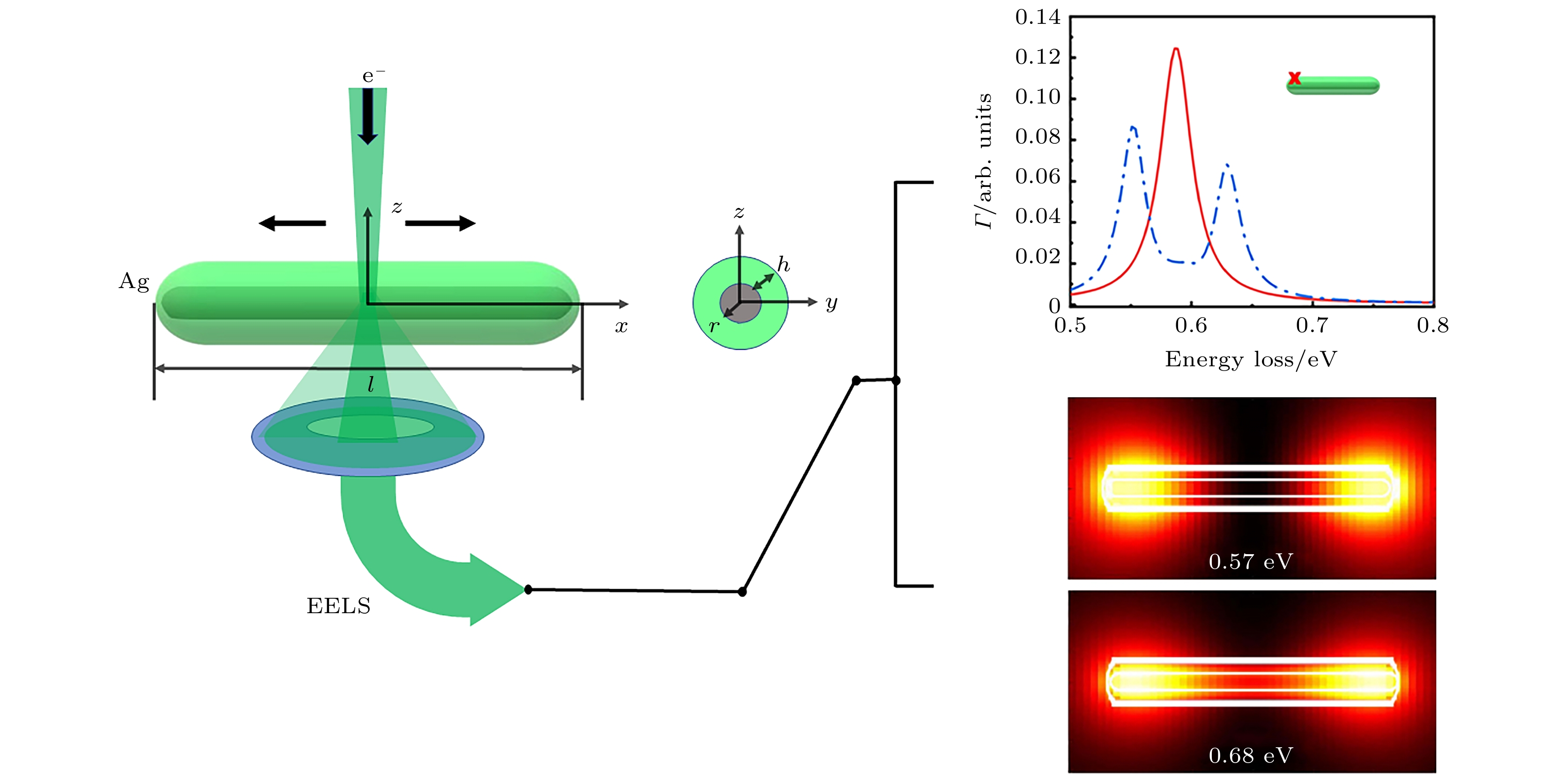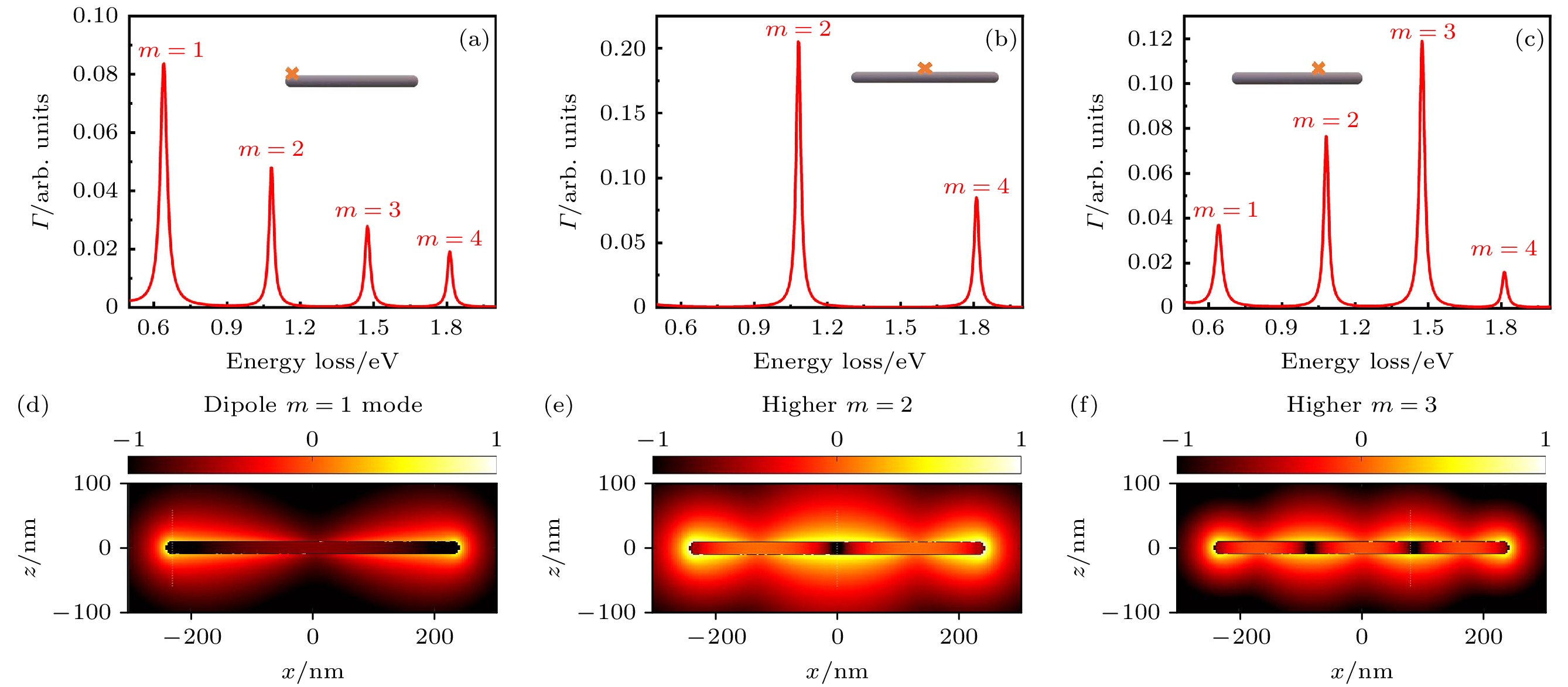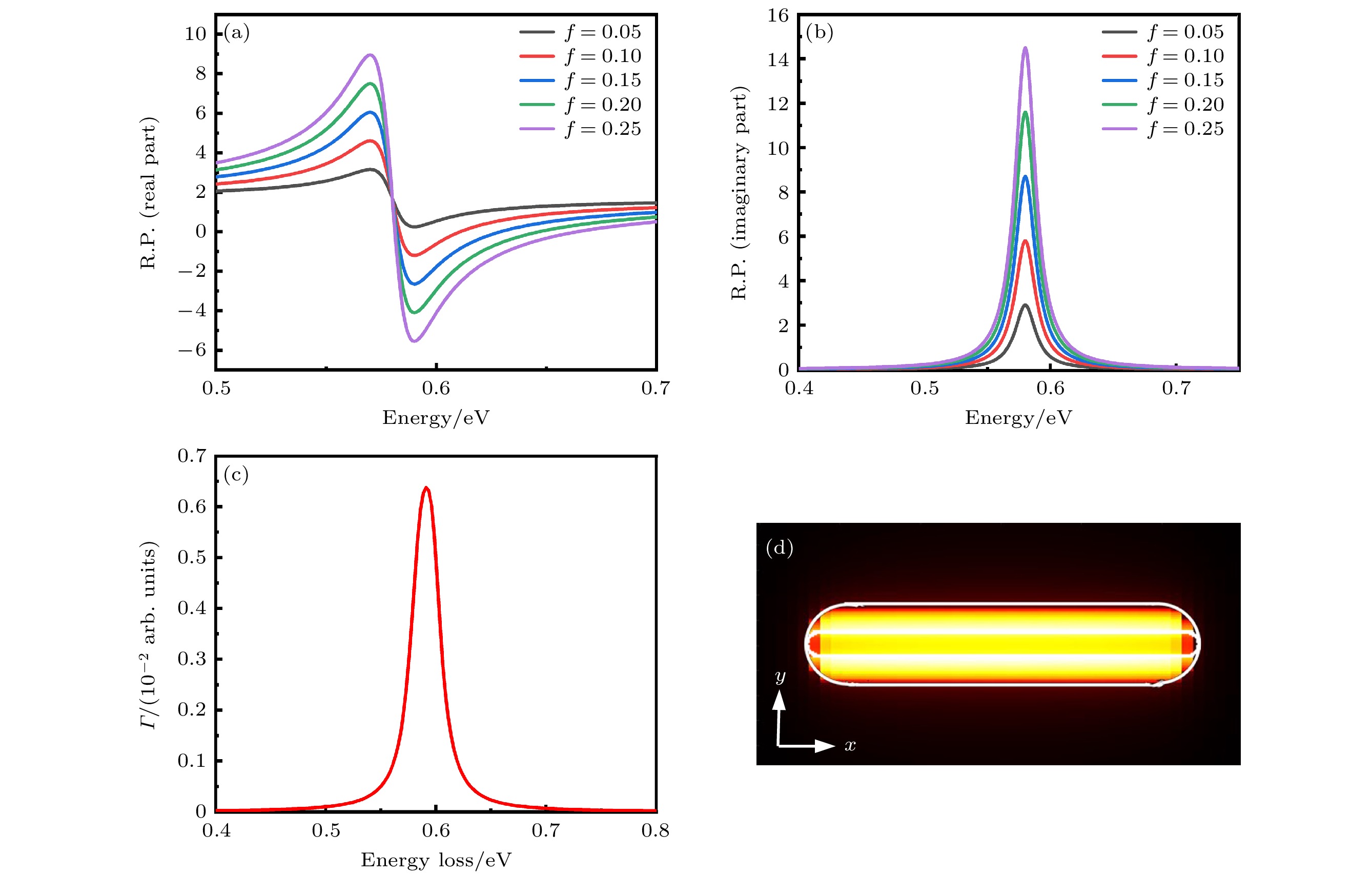-
The strong coupling phenomenon between surface plasmons and quantum emitters has received extensive attention in recent years. It is usually studied by the far-field spectral detection method such as scattering, absorption, and fluorescence. In the electron energy loss spectroscopy (EELS), highly focused electron beams are used for implementing the local detection on a sub-nanometer scale, which can be more effective to study strong coupling. In this work, the electron energy loss spectrum of silver nanorods, dielectric materials and their composite core-shell nanostructures are theoretically simulated respectively, and the energy and mode characteristics of surface plasmons on the silver nanorods and the excitation characteristics of dielectric materials are obtained. The electron energy loss spectrum of surface plasmon is basically consistent with the related experimental result. Rabi splitting of spectral peaks is observed in the electron energy loss spectra of the above composite structures, and the effect of Ag nanorod size on Rabi splitting is explored. The strong coupling between the radiative dipolar and non-radiative higher-order plasmon with the excitation of the dielectric materials in the infrared and visible band is discussed, and the corresponding dispersion relation is analyzed with the coupled oscillator mode. Furthermore, the plexciton caused by strong coupling are discussed from the perspective of spatial distribution of loss spectrum imaging. Our study builds the basis for further theoretical study, and can guide the further experimental research.
-
Keywords:
- electron energy loss spectrum /
- surface plasmon /
- strong coupling
[1] Hamann H F, Kuno M, Gallagher A, Nesbitt D J 2001 J. Chem. Phys. 114 8596
 Google Scholar
Google Scholar
[2] Hartschuh A, Sanchez E J, Xie X S, Novotny L 2003 Phys. Rev. Lett. 90 095503
 Google Scholar
Google Scholar
[3] Fleischmann M, Hendra P J, McQuillan A J 1974 Chem. Phys. Lett. 26 163
 Google Scholar
Google Scholar
[4] Nie S, Emory S R 1997 Science 275 1102
 Google Scholar
Google Scholar
[5] Osawa M, Ikeda 1991 J. Phys. Chem. 95 9914
 Google Scholar
Google Scholar
[6] Hirsch L, Stafford R J, Bankson J A, Sershen 2003 Proc. Natl. Acad. Sci. 100 13549
 Google Scholar
Google Scholar
[7] Cao Y C, Jin R, Mirkin C A 2002 Science 297 1536
 Google Scholar
Google Scholar
[8] Rossouw D, Couillard M, Vickery J, Kumacheva E, Botton G A 2011 Nano Lett. 11 1499
 Google Scholar
Google Scholar
[9] Aizpurua J, Hanarp P, Sutherland D S, Käll M, Bryant G W, García de Abajo F J 2003 Phys. Rev. Lett. 90 057401
 Google Scholar
Google Scholar
[10] Yankovich A B, Munkhbat B, Baranov D G, Cuadra J, Olsén E, Lourenço-Martins H, Tizei L H G, Kociak M, Eva Olsson, Shegai T 2019 Nano Lett. 19 8171
 Google Scholar
Google Scholar
[11] Zanfrognini M, Rotunno E, Frabboni S, Sit A, Karimi E, Hohenester U, Grillo V 2019 ACS Photon. 6 620
 Google Scholar
Google Scholar
[12] Benz F, Schmidt M K, Dreismann A, Chikkaraddy R, Zhang Y, Demetriadou A, Carnegie C, Ohadi H, De Nijs B, Esteban R, Aizpurua J, Baumberg J J 2016 Science 354 726
 Google Scholar
Google Scholar
[13] Lee J, Tallarida N, Chen X, Liu P, Jensen L, Apkarian V A 2017 ACS Nano 11 11466
 Google Scholar
Google Scholar
[14] Carnegie C, Griffiths J, de Nijs B, Readman C, Chikkaraddy R, Deacon W M, Zhang Y, Szabó I, Rosta E, Aizpurua J, Baumberg J J 2018 J. Phys. Chem. Lett. 9 7146
 Google Scholar
Google Scholar
[15] Urbieta M, Barbry M, Zhang Y, Koval P, Sánchez-Portal D, Zabala N, Aizpurua J 2018 ACS Nano 12 585
 Google Scholar
Google Scholar
[16] Doppagne B, Neuman T, Soria-Martinez R, López L E P, Bulou H, Romeo M, Berciaud S, Scheurer F, Aizpurua J, Schull G 2020 Nature Nanotechnol. 15 207
 Google Scholar
Google Scholar
[17] Nan F, Zhang Y F, Li X G, Zhang X T, Hang Li H, Zhang X H, Jiang R B, Wang J F, Zhang W, Li Zhou, Wang J H, Wang Q Q, Zhang Z Y 2015 Nano Lett. 15 2705
 Google Scholar
Google Scholar
[18] Guo Y Z, Zhu G D, Fanga Y 2021 J. Appl. Phys. 129 043104
 Google Scholar
Google Scholar
[19] Qin J, Chen Y H, Zhang Z P, Zhang Y F, Blaikie R J, Ding B Y, Qiu M 2020 Phys. Rev. Lett. 124 063902
 Google Scholar
Google Scholar
[20] Li P N, Yang X S, Maß T W W, Hanss J, Lewin M, Ann-Katrin U Michel, Wuttig M, Taubner T 2016 Nature Mater. 15 870
 Google Scholar
Google Scholar
[21] Hutchison J A, Schwartz T, Genet C, Devaux E, Ebbesen T W 2012 Angew. Chem. 51 1592
 Google Scholar
Google Scholar
[22] Törmä P, Barnes W L 2015 Rep. Prog. Phys. 78 013901
 Google Scholar
Google Scholar
[23] Konečná A, Neuman T, Aizpurua J, Hillenbrand R 2018 ACS Nano 12 4775
 Google Scholar
Google Scholar
[24] Zhang Y, Meng Q S, Zhang L, Luo Y, Yu Y J, Yang B, Zhang Y, Esteban R, Aizpurua J, Luo Y, Yang J L, Dong Z C, Hou J G 2017 Nat. Commun. 8 15225
 Google Scholar
Google Scholar
[25] Tizei L H G, Mkhitaryan V, Lourenço-Martins H, et al. 2020 Nano Lett. 20 2973
 Google Scholar
Google Scholar
[26] Liu H H, Gage T E, Singh P, Jaiswal A, Schaller R D, Tang J, Park S T, Gray S K, Arslan I 2021 Nano Lett. 21 5842
 Google Scholar
Google Scholar
[27] Wei J K, Jiang N, Xu J, Bai X D, Liu J Y 2015 Nano Lett. 15 5926
 Google Scholar
Google Scholar
[28] Lagos M J, Batson P E, Lyu Z, Hohenester U 2021 ACS Photon. 8 1293
 Google Scholar
Google Scholar
[29] Zouros G P, Kolezas G D, N Asger Mortensen, Christos Tserkezis 2020 Phys. Rev. B 101 085416
 Google Scholar
Google Scholar
[30] Goodman J J, Draine B T, Flatau P J 1991 Opt. Lett. 16 1198
 Google Scholar
Google Scholar
[31] Yee K S 1966 IEEE T. Antenn. Propag. 14 302
 Google Scholar
Google Scholar
[32] de Abajo F J G, Howie A 2002 Phys. Rev. B 65 115418
 Google Scholar
Google Scholar
[33] Hohenester U 2014 Computer Phys. Commun. 185 1177
 Google Scholar
Google Scholar
[34] Hohenester U, Trügler A 2012 Computer Phys. Commun. 183 370
 Google Scholar
Google Scholar
[35] Johnson P, Christy R 1972 Phys. Rev. B 6 4370
 Google Scholar
Google Scholar
[36] Maomao Zhang, Xueyi Shi, Xinyu Mu, Luxia Wang, Kun Gao 2021 Appl. Phys. Lett. 118 133301
 Google Scholar
Google Scholar
[37] Hachtel J A, Huang J S, Popovs I, Jansone-Popova S, Keum J K, Jakowski J, Lovejoy T C, Dellby N, Krivanek O L, Idrobo J C 2019 Science 363 525
 Google Scholar
Google Scholar
[38] Rudin S, Reinecke T L 1999 Phys. Rev. B 59 10227
[39] Manjavacas A, de Abajo F J G, Nordlander P 2011 Nano Lett. 11 2318
 Google Scholar
Google Scholar
[40] Autore M, Li P, Dolado I, et al. 2018 Light:Science & Applications 7 17172
[41] Santhosh K, Bitton O, Chuntonov L, Haran G 2016 Nat. Commun. 10 1038
 Google Scholar
Google Scholar
[42] Chikkaraddy R, de Nijs B, Benz F, Barrow S J, Scherman O A, Rosta E, Demetriadou A, Fox P, Hess O, Baumberg J J 2016 Nature 535 127
 Google Scholar
Google Scholar
-
图 1 银纳米棒-介质层系统的电子损失探测示意图. 电子束沿z轴负方向入射, 作用于纳米核壳结构上, 出射电子能量损失谱表征体系支持的激发. 核壳结构的长度为
$ l = 481{\text{ nm}} $ , 核心部分为直径$ {\text{2}}r{\text{ = 20 nm}} $ 的银纳米棒, 介质层厚度$ h{\text{ = 20 nm}} $ ; 右图为强耦合导致电子能量损失谱中峰的拉比劈裂, 以及劈裂峰对应的能量损失空间分布图Figure 1. Schematic diagram of electron loss detection of silver nanorod-dielectric layer system. The incident electron beam is along the negative direction of z axis and acts on the core-shell nano-structure with length l = 481 nm, and the electron energy loss spectrum characterizes the excitation supported by the system. The nanostructure is made of a silver nanorod core with a diameter
$ {\text{2}}r{\text{ = 20 nm}} $ and a dielectric layer with a thickness of$ h{\text{ = 20 nm}} $ . The figure on the right side shows the Rabi splitting of the peak in the electron energy loss spectrum caused by strong coupling, and the spatial map of the energy loss corresponding to the splitting peaks.图 2 实验测量和理论模拟的银纳米棒 (a), (b) 电子能量损失谱及(c), (d)不同损失能量下的空间成像的对比 (a), (c) 实验测量结果[8]; (b), (d) 理论模拟结果
Figure 2. Comparison of experimental measurements and theoretical simulations of electron energy loss spectrum (a), (b) and electron energy loss spatial distribution map under different loss energies (c), (d) of silver nanorods: (a), (c) Experimental measurements[8]; (b), (d) theoretical simulations.
图 3 电子束作用于银纳米棒的(a)尖端, (b)中部和(c) 1/3长度处的电子能量损失谱; 电子束作用于银纳米棒不同位置不同激发能量的归一化电场分布 (d)尖端, 0.65 eV; (e)中间, 1.08 eV; (f) 1/3处, 1.46 eV
Figure 3. Electron energy loss spectrum for an electron beam at the (a) tip, (b) middle and (c) 1/3 length of a silver nanorod; the normalized electric field distribution with different excited energy by the electron beam acting on the different positions of the silver nanorod: (d) Tip, 0.65 eV; (e) middle, 1.08 eV; (f) 1/3 of the length, 1.46 eV.
图 4 通过改变银纳米棒尺寸来主动调控表面等离激元激发 (a) 直径20 nm不变, 改变银纳米棒的长度, 在棒的尖端激发得到的一系列电子能量损失谱; (b)长度481 nm不变, 改变纳米棒的直径, 在尖端激发得到的一系列电子能量损失谱; (c)偶极表面等离激元激发能量随银纳米棒长度的倒数(π/L)的比例关系
Figure 4. Actively regulate surface plasmon excitation by changing the size of silver nanorods: (a) Electron energy loss spectrum obtained from an electron beam acting on a silver nanorod with the fixed diameter 20 nm and increasing length; (b) the electron energy loss spectrum obtained from an electron beam acting on a silver nanorod with fixed length 481 nm and increasing diameter; (c) dipole plasmon excitation energy as a function of the inverse of the silver nanorod length (π/L).
图 5 介质层介电函数的(a)实部和(b)虚部随能量的变化(R.P.指相对介电常数); 0.58 eV处介质层的(c)电子能量损失谱和(d)电子能量损失空间分布图
Figure 5. Real (a) and imaginary (b) parts of the dielectric layer dielectric function as a function of energy (R. P. refers to relative permittivity); (c) the electron energy loss spectrum and (d) the electron energy loss spatial distribution map of the dielectric layer at 0.58 eV energy.
图 6 利用EELS探测红外波段偶极辐射表面等离激元模式和介质层的强耦合 (a)电子束作用于介质层尖端(黑实线), 银纳米棒尖端(红虚线)及银纳米棒-介质层核壳结构尖端(蓝色点线)的电子能量损失谱; 红移后偶极表面等离激元与介质层的元激发能量(b)零失谐与(c)失谐时, 在不同能量处劈裂峰对应的电子能量损失概率空间成像
Figure 6. Strong coupling between the infrared radiation dipole surface plasmon mode and the dielectric layer detected by EELS: (a) Electron energy loss spectrum of an electron beam acting on the tip of the dielectric layer (black solid line), the tip of silver nanorods (red dotted line) and the tip of the silver nanorod-dielectric layer core-shell structure (blue dotted line); spatial distribution of electron energy loss probability for two splitting peaks with different energies when the surface plasmon energy is (b) zero detuned and (c) detuned from the meta excitation energy of the dielectric layer.
图 7 不同波段辐射偶极和非辐射高级表面等离激元与介质层元激发间强耦合导致的反交叉色散关系 (a), (b) 直径为20 nm、不同长度的银纳米棒-介质层核壳结构的电子能量损失谱 (虚线标注了上、下杂化等离激子的能量) (a) 红外波段; (b) 可见波段; (c), (d) 对应的杂化等离激子能量的色散关系 (横虚线为介质层激发能量, 斜虚线为银纳米棒的偶极(m = 1, 4)表面等离激元能量)
Figure 7. Anti-crossing dispersion relationship caused by the strong coupling between the radiative dipolar and non-radiative higher-order plasmon in different range and the excitation of dielectric layer. (a), (b) Electron energy loss spectrum of silver nanorod-dielectric layer core-shell structures with a diameter of 20 nm and different lengths (The dotted lines mark the energies of the upper and lower plexciton): (a) Infrared range; (b) visible range; (c), (d) corresponding dispersion relationship of the plexciton energy (The horizontal dotted line is the excitation energy of the dielectric layer, and the oblique line is the energy of dipole (m = 1, 4) radiative plasmon of the silver nanorod).
-
[1] Hamann H F, Kuno M, Gallagher A, Nesbitt D J 2001 J. Chem. Phys. 114 8596
 Google Scholar
Google Scholar
[2] Hartschuh A, Sanchez E J, Xie X S, Novotny L 2003 Phys. Rev. Lett. 90 095503
 Google Scholar
Google Scholar
[3] Fleischmann M, Hendra P J, McQuillan A J 1974 Chem. Phys. Lett. 26 163
 Google Scholar
Google Scholar
[4] Nie S, Emory S R 1997 Science 275 1102
 Google Scholar
Google Scholar
[5] Osawa M, Ikeda 1991 J. Phys. Chem. 95 9914
 Google Scholar
Google Scholar
[6] Hirsch L, Stafford R J, Bankson J A, Sershen 2003 Proc. Natl. Acad. Sci. 100 13549
 Google Scholar
Google Scholar
[7] Cao Y C, Jin R, Mirkin C A 2002 Science 297 1536
 Google Scholar
Google Scholar
[8] Rossouw D, Couillard M, Vickery J, Kumacheva E, Botton G A 2011 Nano Lett. 11 1499
 Google Scholar
Google Scholar
[9] Aizpurua J, Hanarp P, Sutherland D S, Käll M, Bryant G W, García de Abajo F J 2003 Phys. Rev. Lett. 90 057401
 Google Scholar
Google Scholar
[10] Yankovich A B, Munkhbat B, Baranov D G, Cuadra J, Olsén E, Lourenço-Martins H, Tizei L H G, Kociak M, Eva Olsson, Shegai T 2019 Nano Lett. 19 8171
 Google Scholar
Google Scholar
[11] Zanfrognini M, Rotunno E, Frabboni S, Sit A, Karimi E, Hohenester U, Grillo V 2019 ACS Photon. 6 620
 Google Scholar
Google Scholar
[12] Benz F, Schmidt M K, Dreismann A, Chikkaraddy R, Zhang Y, Demetriadou A, Carnegie C, Ohadi H, De Nijs B, Esteban R, Aizpurua J, Baumberg J J 2016 Science 354 726
 Google Scholar
Google Scholar
[13] Lee J, Tallarida N, Chen X, Liu P, Jensen L, Apkarian V A 2017 ACS Nano 11 11466
 Google Scholar
Google Scholar
[14] Carnegie C, Griffiths J, de Nijs B, Readman C, Chikkaraddy R, Deacon W M, Zhang Y, Szabó I, Rosta E, Aizpurua J, Baumberg J J 2018 J. Phys. Chem. Lett. 9 7146
 Google Scholar
Google Scholar
[15] Urbieta M, Barbry M, Zhang Y, Koval P, Sánchez-Portal D, Zabala N, Aizpurua J 2018 ACS Nano 12 585
 Google Scholar
Google Scholar
[16] Doppagne B, Neuman T, Soria-Martinez R, López L E P, Bulou H, Romeo M, Berciaud S, Scheurer F, Aizpurua J, Schull G 2020 Nature Nanotechnol. 15 207
 Google Scholar
Google Scholar
[17] Nan F, Zhang Y F, Li X G, Zhang X T, Hang Li H, Zhang X H, Jiang R B, Wang J F, Zhang W, Li Zhou, Wang J H, Wang Q Q, Zhang Z Y 2015 Nano Lett. 15 2705
 Google Scholar
Google Scholar
[18] Guo Y Z, Zhu G D, Fanga Y 2021 J. Appl. Phys. 129 043104
 Google Scholar
Google Scholar
[19] Qin J, Chen Y H, Zhang Z P, Zhang Y F, Blaikie R J, Ding B Y, Qiu M 2020 Phys. Rev. Lett. 124 063902
 Google Scholar
Google Scholar
[20] Li P N, Yang X S, Maß T W W, Hanss J, Lewin M, Ann-Katrin U Michel, Wuttig M, Taubner T 2016 Nature Mater. 15 870
 Google Scholar
Google Scholar
[21] Hutchison J A, Schwartz T, Genet C, Devaux E, Ebbesen T W 2012 Angew. Chem. 51 1592
 Google Scholar
Google Scholar
[22] Törmä P, Barnes W L 2015 Rep. Prog. Phys. 78 013901
 Google Scholar
Google Scholar
[23] Konečná A, Neuman T, Aizpurua J, Hillenbrand R 2018 ACS Nano 12 4775
 Google Scholar
Google Scholar
[24] Zhang Y, Meng Q S, Zhang L, Luo Y, Yu Y J, Yang B, Zhang Y, Esteban R, Aizpurua J, Luo Y, Yang J L, Dong Z C, Hou J G 2017 Nat. Commun. 8 15225
 Google Scholar
Google Scholar
[25] Tizei L H G, Mkhitaryan V, Lourenço-Martins H, et al. 2020 Nano Lett. 20 2973
 Google Scholar
Google Scholar
[26] Liu H H, Gage T E, Singh P, Jaiswal A, Schaller R D, Tang J, Park S T, Gray S K, Arslan I 2021 Nano Lett. 21 5842
 Google Scholar
Google Scholar
[27] Wei J K, Jiang N, Xu J, Bai X D, Liu J Y 2015 Nano Lett. 15 5926
 Google Scholar
Google Scholar
[28] Lagos M J, Batson P E, Lyu Z, Hohenester U 2021 ACS Photon. 8 1293
 Google Scholar
Google Scholar
[29] Zouros G P, Kolezas G D, N Asger Mortensen, Christos Tserkezis 2020 Phys. Rev. B 101 085416
 Google Scholar
Google Scholar
[30] Goodman J J, Draine B T, Flatau P J 1991 Opt. Lett. 16 1198
 Google Scholar
Google Scholar
[31] Yee K S 1966 IEEE T. Antenn. Propag. 14 302
 Google Scholar
Google Scholar
[32] de Abajo F J G, Howie A 2002 Phys. Rev. B 65 115418
 Google Scholar
Google Scholar
[33] Hohenester U 2014 Computer Phys. Commun. 185 1177
 Google Scholar
Google Scholar
[34] Hohenester U, Trügler A 2012 Computer Phys. Commun. 183 370
 Google Scholar
Google Scholar
[35] Johnson P, Christy R 1972 Phys. Rev. B 6 4370
 Google Scholar
Google Scholar
[36] Maomao Zhang, Xueyi Shi, Xinyu Mu, Luxia Wang, Kun Gao 2021 Appl. Phys. Lett. 118 133301
 Google Scholar
Google Scholar
[37] Hachtel J A, Huang J S, Popovs I, Jansone-Popova S, Keum J K, Jakowski J, Lovejoy T C, Dellby N, Krivanek O L, Idrobo J C 2019 Science 363 525
 Google Scholar
Google Scholar
[38] Rudin S, Reinecke T L 1999 Phys. Rev. B 59 10227
[39] Manjavacas A, de Abajo F J G, Nordlander P 2011 Nano Lett. 11 2318
 Google Scholar
Google Scholar
[40] Autore M, Li P, Dolado I, et al. 2018 Light:Science & Applications 7 17172
[41] Santhosh K, Bitton O, Chuntonov L, Haran G 2016 Nat. Commun. 10 1038
 Google Scholar
Google Scholar
[42] Chikkaraddy R, de Nijs B, Benz F, Barrow S J, Scherman O A, Rosta E, Demetriadou A, Fox P, Hess O, Baumberg J J 2016 Nature 535 127
 Google Scholar
Google Scholar
-
 147302-20220194补充材料.pdf
147302-20220194补充材料.pdf

Catalog
Metrics
- Abstract views: 3663
- PDF Downloads: 84
- Cited By: 0






















 DownLoad:
DownLoad:






